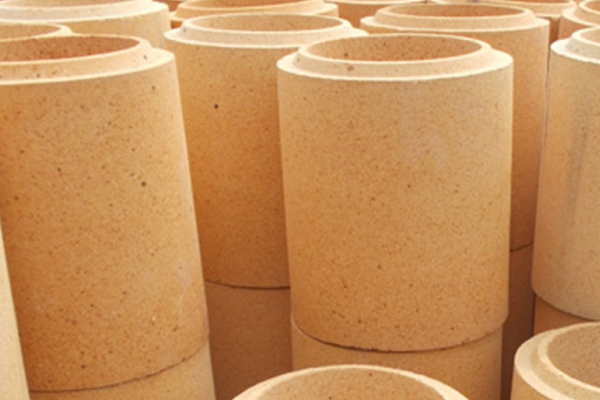مقدمة
عمليات درجات الحرارة العالية, مثل تكرير المعادن, تصنيع الزجاج, وإنتاج الأسمنت, تتطلب مواد يمكنها تحمل درجات الحرارة القصوى والبيئات القاسية دون تدهور كبير.
يعد الطوب الحراري مكونات أساسية في العمليات ذات درجات الحرارة العالية, لأنها توفر الحماية للمعدات, منع فقدان الحرارة, والحفاظ على توحيد درجة الحرارة. يمكن صنع طوب النار الحراري من مجموعة متنوعة من المواد, لكل منها خصائص وتطبيقاتها الفريدة.
سيناقش هنا كل الحراريات دور الطوب الحراري المصنوع من مواد مختلفة في عمليات درجات الحرارة العالية, بما في ذلك خصائصهم, أنواع, والتطبيقات.


خصائص الطوب الحراري
تم تصميم الطوب الحراري لمقاومة درجات الحرارة العالية والبيئات القاسية, جعلها مثالية للاستخدام في عمليات درجات الحرارة العالية. تشمل خصائص الطوب الحراري التي تجعلها مناسبة لمثل هذه التطبيقات:
نقطة انصهار عالية: الطوب المقاوم للحريق لديهم نقطة انصهار عالية, السماح لهم بتحمل درجات حرارة عالية دون ذوبان أو تحلل.
الموصلية الحرارية المنخفضة: الطوب الحراري لها توصيل حراري منخفض, مما يمنع فقدان الحرارة ويساعد على الحفاظ على توحيد درجة الحرارة في العملية.
الاستقرار الكيميائي: الطوب المقاوم للهب مستقرة كيميائيا ومقاومة للتآكل والتآكل, ضمان المتانة على المدى الطويل.
القوة الميكانيكية: الطوب الحراري لها قوة ميكانيكية عالية, السماح لهم بتحمل الضغوط الميكانيكية والاهتزازات دون كسر.
أنواع الطوب الحراري
يمكن صنع الطوب الحراري من مجموعة متنوعة من المواد, لكل منها خصائص وتطبيقاتها الفريدة. الأنواع الرئيسية من نشرات الحراريات الحرارية:
الطوب Fireclay: طوب Fireclay مصنوع من الطين والمواد الأخرى. لديهم تكلفة منخفضة ويستخدمون عادة في تطبيقات درجات الحرارة المنخفضة, مثل المواقد السكنية.
طوب السيليكا: طوب السيليكا مصنوعة من ثاني أكسيد السيليكون. لديهم نقطة انصهار عالية وتستخدم عادة في تصنيع الزجاج.
طوب ماغنسيا: طوب المغنيسيا مصنوع من أكسيد المغنيسيوم. لديهم نقطة انصهار عالية وتستخدم عادة في صناعة الصلب.
طوب الألومينا العالي: طوب الألومينا العالي مصنوع من أكسيد الألومنيوم. لديهم نقطة انصهار عالية وتستخدم عادة في تطبيقات درجات الحرارة العالية, مثل بطانات الفرن.
طوب الكروم: طوب الكروم مصنوع من أكسيد الكروم. لديهم نقطة انصهار عالية ويتم استخدامها بشكل شائع في إنتاج الفيروكروم والسبائك الأخرى.


تطبيقات الطوب الحراري
يتم استخدام الطوب الحراري في مجموعة متنوعة من عمليات درجات الحرارة العالية, بما في ذلك التكرير المعدني, تصنيع الزجاج, وإنتاج الأسمنت. بعض التطبيقات الشائعة للطوب الحراري المصنوع من مواد مختلفة:
بطانات الفرن: يتم استخدام الطوب الحراري لربط الأفران الداخلية, حماية جدران الفرن من درجات حرارة عالية ومنع فقدان الحرارة.
يتم استخدام أنواع مختلفة من الطوب الحراري اعتمادًا على درجة حرارة وبيئة العملية. يتم استخدام الطوب Fireclay بشكل شائع في تطبيقات درجات الحرارة المنخفضة, بينما يتم استخدام طوب الألومينا في تطبيقات درجات الحرارة العالية.
بطانات الفرن: يتم استخدام نشرات الحراريات لتصوير الأفران, التي تستخدم في تصنيع سيراميك, يبني, وغيرها من المواد.
تحمي البطانة الحرارية جدران الفرن من درجات حرارة عالية وتمنع فقدان الحرارة. تستخدم طوب السيليكا بشكل شائع في بطانات الفرن بسبب انصهارها العالي والاستقرار الكيميائي.
البوتقة: يتم استخدام طوب النار الحراري لصنع البوتقات, وهي حاويات تستخدم لعقد المعادن المنصهرة أثناء عملية الصب.
تمنع المادة الحرارية البوتقة من الذوبان وتضمن بقاء المعدن في درجة حرارة متسقة. تُستخدم طوب المغنيسيا بشكل شائع في البوتقات بسبب نقطة انصهار عالية ومقاومة للتآكل.
الأفران الزجاجية: يتم استخدام طوب النار على نطاق واسع في صناعة التصنيع الزجاجي.
تتطلب الأفران الزجاجية بطانة يمكنها تحمل درجات حرارة عالية وبيئات كيميائية قاسية. تستخدم طوب السيليكا بشكل شائع في بطانات الأفران الزجاجية بسبب انصهارها العالية ومقاومة القلويات.
صناعة الصلب: يتم استخدام الطوب الحراري في صناعة الصلب لربط وعاء صناعة الصلب وحمايته من درجات الحرارة العالية والتفاعلات الكيميائية.
تستخدم طوب المغنيسيا وطوب الألومينا بشكل شائع في صناعة الصلب بسبب انصهارها العالي والاستقرار الكيميائي.
شركة مصنعة ومورد من الطوب الحراري
ختاماً, تلعب الطوب الحراري دورًا حاسمًا في عمليات درجات الحرارة العالية من خلال توفير الحماية للمعدات, منع فقدان الحرارة, والحفاظ على توحيد درجة الحرارة.
خصائص الطوب الحراري, مثل نقطة الانصهار العالية, الموصلية الحرارية المنخفضة, الاستقرار الكيميائي, والقوة الميكانيكية, اجعلها مناسبة للاستخدام في مختلف تطبيقات درجات الحرارة العالية.
مختلف أنواع الطوب الحراري, مثل Fireclay Firebricks, حريق السيليكا, طوب المغنيسيا, طوب عالي الألومينا, والكروم الطوب, تستخدم اعتمادا على درجة حرارة وبيئة العملية. يمكن أن يضمن استخدام الطوب الحراري المناسبين في العمليات ذات درجة الحرارة العالية المتانة والكفاءة على المدى الطويل.
